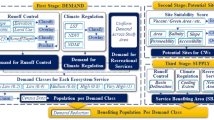Abstract
Wetland constitutes the most important environmental resource for mankind. In the past half century, rapid population growth and excessive use of wetland resources led to its lower functions, gradual wetland exploitation, and unreasonable development and usage. To implement river wetland landscape planning and design from low-carbon perspective, river compound functions compatible with urban functions are considered; landscape is taken as a green infrastructure, landscape infrastructure in construction, while cultural and experience design and ecological restoration and protection are taken as design points. In addition, systematic planning is used to optimize the overall layout, system planning, and engineering design in urban river wetland landscape planning and design and establish symbiosis development relationship between the river and the city, thereby effectively coordinating the relationship between ecology and economy and society and leisure activities. Meanwhile, low-carbon effect of river wetland landscape planning is evaluated through analytic hierarchy process-based low-carbon evaluation model of river wetland landscape planning. River wetland of the Yellow River National Wetland Park in Jinan is taken as an example for landscape planning and design. Analytic hierarchy process-based low-carbon evaluation model of river wetland landscape planning is used to evaluate five sampling points of the designed river wetland, revealing that the correlation coefficients (low carbon index) are respectively 0.6512, 0.6647, 0.6320, 0.6907, and 0.6292. Hence, wetland sampling site 4 has optimal low carbon level. Although there is still a certain gap from the low-carbon standard for tourist attractions formulated by the state, sampling point 4 has a correlation degree of 0.6907, which approaches 0.7. Low-carbon planning of river wetland landscape demands long-term implementation. Low-carbon index is expected to further grow in the future.



Similar content being viewed by others
Change history
06 December 2021
This article has been retracted. Please see the Retraction Notice for more detail: https://doi.org/10.1007/s12517-021-09189-3
28 September 2021
An Editorial Expression of Concern to this paper has been published: https://doi.org/10.1007/s12517-021-08471-8
References
Bird MS, Day JA (2016) Impacts of terrestrial habitat transformation on temporary wetland invertebrates in a sclerophyllous Sand fynbos landscape. Hydrobiologia 782(1):169–185
Coldren GA, Barreto CR, Wykoff DD (2016) Chronic warming stimulates growth of marsh grasses more than mangroves in a coastal wetland ecotone. Ecology 97(11):3167–3175
Craig W, James S, Atun Z (2016) Holocene ecosystem change in Little Llangothlin Lagoon, Australia: implications for the management of a Ramsar-listed wetland. Hydrobiologia 85(1):1–22
Cui FX, Research on energy construction and application of CNC machine tools for low carbon, Autom Instrum, 2017, 37(10), 190-191+194.
Kumwimba MN, Li XZ, Wang W, De Silva LHDKU, Bao LL, Mihiranga HKM, Su JJ, Li XY (2021) Large-scale hybrid accidental urban wetland for polluted river purification in northern China: evidence and implications for urban river management. Environ Technol Innov 22:101542. https://doi.org/10.1016/j.eti.2021.101542
Liang JC, Xian DL, Wen PG (2016) Diversity and evolution of avian influenza viruses in live poultry markets, free range poultry and wild wetland birds in China. J Gen Virol 97(4):844–854
Luciana MV, Tainá F, Dorado R (2016) Vegetation structure and hydroperiod affect anuran composition in a large neotropical wetland. Herpetologica 72(3):181–188
Lulu P, Leslie R, Brown GJ (2016) The ecology and classification of wetland vegetation in the Maputaland Coastal Plain, South Africa. Phytocoenologia 46(2):125–139
Mammarella I, Peltola O, Nordbo A (2016) Quantifying the uncertainty of eddy covariance fluxes due to the use of different software packages and combinations of processing steps in two contrasting ecosystems. J Biol Chem 9(10):4915–4933
Ramani U, Thilagaraj M, Nair RKR, & Dharinee J (2021). Neural network based hybrid power scheme with constant output using three DC source. Materials Today: Proceedings. https://doi.org/10.1016/j.matpr.2020.12.888
Sethy PK, Pandey C, Khan D, Rafique M, Behera SK, VijaykumarK, & PanigrahiD (2021). A cost-effective computer-vision based breast cancer diagnosis. J Intell Fuzzy Syst, Issue Pre-press:1–11
Stéphanie G, Ignasi A, Miguel C (2016) Environmental filtering determines metacommunity structure in wetland microcrustaceans. Oecologia 181(1):193–205
Van dBRJG, Verbrugge LNH, Ganzevoort W (2020) Assessing stakeholder perceptions of landscape and place in the context of a major river intervention: a call for their inclusion in adaptive management. Water Policy 22(1CD):19–36
Thilagaraj M, Arunkumar N, Ramkumar S, Hariharasitaraman S (2021b) Electrooculogram signal identification for elderly disabled using Elman network. Microprocess Microsyst 82:103811
Vijaykumar K, Baskaran M, Gayathri V, Gayathri P (2020) Design of 4× 4 antenna array for breast cancer detection. Analog Integr Circ Sig Process 105(3):395–406
Wang DL, He YG, Xie F (2016) Power quality analysis and remote monitoring system based on LabVIEW. Chin J Power Sources 40(04):881–884
Xiong G.W., Multimodal transportation planning of low carbon logistics, Computer Simulation, 2016, 33(06), 149-153+222.
Yang XY, Dong WH, Lu J (2018) Effects of biochar on phytoplankton community in iris wilsonii wetland. J Jilin Univ (Sci Ed) 56(01):184–189
Zhang BF, Xu JM, Qian Q (2016a) Analysis on characteristics of SiC MOSFET and key techniques of its applications. J Power Supply 14(04):39–51
Zhang P, Qin ZC, Lu Z (2016b) An analytical model of space backbone network capacity for space information transmission. J China Acad Electron Inf Technol 11(1):66–72
Funding
The research is supported by the National Natural Science Foundation of China (Grant No.51878279): Study on the cooling effect mechanism from horizontal and vertical impact for layout optimization of urban green and blue space
Author information
Authors and Affiliations
Corresponding author
Ethics declarations
Conflict of interest
The authors declare that they have no competing interests.
Additional information
Responsible Editor: Sheldon Williamson
This article is part of the Topical Collection on Environment and Low Carbon Transportation.
This article has been retracted. Please see the retraction notice for more detail:https://doi.org/10.1007/s12517-021-09189-3
About this article
Cite this article
Li, Q., Wang, P. RETRACTED ARTICLE: River wetland landscape planning and design from low-carbon perspective. Arab J Geosci 14, 863 (2021). https://doi.org/10.1007/s12517-021-07262-5
Received:
Accepted:
Published:
DOI: https://doi.org/10.1007/s12517-021-07262-5




